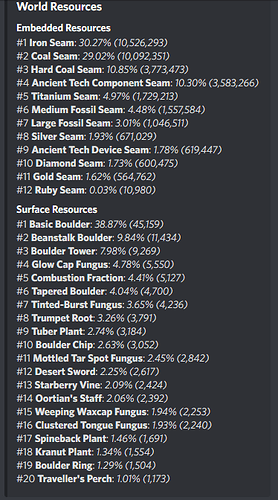I’m going to try and rescue a side conversation that was off topic in a now-missing thread. I’m stating that because I’m about to quote some stuff without actual forum “quotes”.
I was always curious. Do planets get…worse over time. … But, do hot spots move, do they thin out? Get replaced with other things? I always wondered if if fresh planets were best.
So, we actually have some dev info on this.
So far as I can tell, the nodes do not move, but they do start regenning slower and slower the more you mine them.
The nodes actually do not move. The “per chunk” resource composition is set at the time of planet generation, and does not change. Before this was explained I did several experiments trying to re-create the spawn conditions for certain materials. This explanation saved me a ton of time ![]()
The next bit led to some more experiments, which honestly I never pushed to any conclusion. But here it is:
When you harvest a resource, clearly, it’s going to trigger regen. Apparently, regeneration is done according to the chunk’s resource composition, and this leads to “thinning spawns”. I’ll do some searching in a minute because I don’t want to re-create a ton of text here.
In short, if you harvest a diamond, a flower may re-spawn in it’s place. Or some coal. By the same token if someone cleans up the ground cover - minerals can spawn back.
If you stop mining them for a while, they will fully regen over a couple of weeks back to the point they were at when they were fresh.
I’m not sure what does this, as I share this impression but it’s not something that I remember any reveal of. But it seems like if an area is left alone long enough, it sort of adjusts back to it’s original balance.
In any case, there’s nothing like “that new planet feeling” for sure ![]()
Have tested planet resource respawns thoroughly but that conversation would derail this thread even more.
Brother, this thread is for you… Please feel free.


